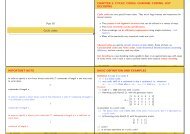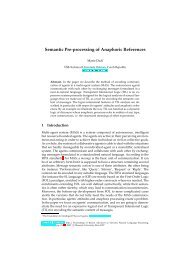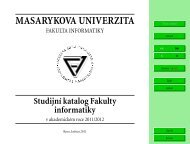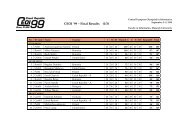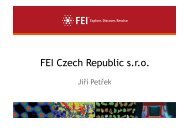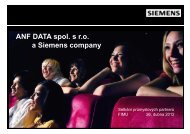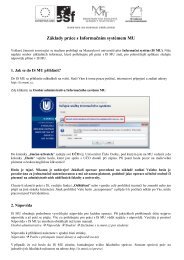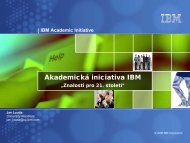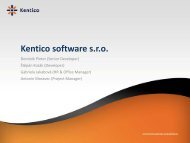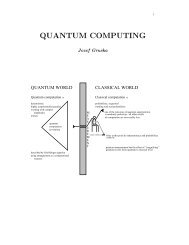Automatic Transcription of Czech Language Oral History in the ...
Automatic Transcription of Czech Language Oral History in the ...
Automatic Transcription of Czech Language Oral History in the ...
Create successful ePaper yourself
Turn your PDF publications into a flip-book with our unique Google optimized e-Paper software.
<strong>Automatic</strong> <strong>Transcription</strong> <strong>of</strong> <strong>Czech</strong> <strong>Language</strong><br />
<strong>Oral</strong> <strong>History</strong> <strong>in</strong> <strong>the</strong> MALACH Project:<br />
Resources and Initial Experiments ⋆<br />
Josef Psutka 1 , Pavel Irc<strong>in</strong>g 1 , Josef V. Psutka 1 , Vlasta Radová 1 ,<br />
William Byrne 2 , Jan Hajič 3 , Samuel Gustman 4 , and Bhuvana Ramabhadran 5<br />
1 University <strong>of</strong> West Bohemia, Department <strong>of</strong> Cybernetics<br />
Univerzitní 8, 306 14 Plzeň, <strong>Czech</strong> Republic<br />
{psutka, irc<strong>in</strong>g, psutka j, radova}@kky.zcu.cz<br />
2 Johns Hopk<strong>in</strong>s University, Center for <strong>Language</strong> and Speech Process<strong>in</strong>g<br />
309 Barton Hall, 3400 N. Charles St., Baltimore, MD 21218<br />
byrne@jhu.edu<br />
3 Charles University, Institute <strong>of</strong> Formal and Applied L<strong>in</strong>guistic<br />
Malostranské náměstí 25, 118 00 Praha, <strong>Czech</strong> Republic<br />
hajic@ufal.mff.cuni.cz<br />
4 Survivors <strong>of</strong> <strong>the</strong> Shoah Visual <strong>History</strong> Foundation<br />
P.O. Box 3168, Los Angeles, CA 90078-3168<br />
sam@vhf.org<br />
5 IBM T.J. Watson Research Laboratory, Human <strong>Language</strong> Technologies Group<br />
Yorktown Heights, NY<br />
bhuvana@us.ibm.com<br />
Abstract. In this paper we describe <strong>the</strong> <strong>in</strong>itial stages <strong>of</strong> <strong>the</strong> ASR component<br />
<strong>of</strong> <strong>the</strong> MALACH (Multil<strong>in</strong>gual Access to Large Spoken Archives)<br />
project. This project will attempt to provide improved access to <strong>the</strong> large<br />
multil<strong>in</strong>gual spoken archives collected by <strong>the</strong> Survivors <strong>of</strong> <strong>the</strong> Shoah Visual<br />
<strong>History</strong> Foundation (VHF) by advanc<strong>in</strong>g <strong>the</strong> state <strong>of</strong> <strong>the</strong> art <strong>in</strong><br />
automated speech recognition. In order to tra<strong>in</strong> <strong>the</strong> ASR system, it is<br />
necessary to manually transcribe a large amount <strong>of</strong> speech data, identify<br />
<strong>the</strong> appropriate vocabulary, and obta<strong>in</strong> relevant text for language model<strong>in</strong>g.<br />
We give a detailed description <strong>of</strong> <strong>the</strong> speech annotation process;<br />
show <strong>the</strong> specific properties <strong>of</strong> <strong>the</strong> spontaneous speech conta<strong>in</strong>ed <strong>in</strong> <strong>the</strong><br />
archives; and present a basel<strong>in</strong>e speech recognition results.<br />
1 Introduction<br />
After film<strong>in</strong>g Sch<strong>in</strong>dler’s List, Steven Spielberg established <strong>the</strong> Survivors <strong>of</strong> <strong>the</strong><br />
Shoah Visual <strong>History</strong> Foundation (VHF) to develop archives and teach<strong>in</strong>g materials<br />
based on <strong>the</strong> videotaped testimonies given by survivors <strong>of</strong> <strong>the</strong> Holocaust<br />
⋆ This work has been founded by NSF (U.S.A) under <strong>the</strong> Information Technology<br />
Research (ITR) program, NSF IIS Award No. 0122466 and by <strong>the</strong> M<strong>in</strong>istry <strong>of</strong> Education<br />
<strong>of</strong> <strong>the</strong> <strong>Czech</strong> Republic, project No. MSM234200004 and No. LN00A063
<strong>in</strong> order to preserve <strong>the</strong>ir memory and establish a basis for tolerance education<br />
around <strong>the</strong> world for generations to come.<br />
Today, <strong>the</strong> VHF has ga<strong>the</strong>red almost 52,000 testimonies (116,000 hours <strong>of</strong><br />
video) <strong>in</strong> 32 languages to form a 180 terabyte digital library <strong>of</strong> MPEG-1 video.<br />
Several years ago <strong>the</strong> VHF began <strong>the</strong> task <strong>of</strong> manual catalog<strong>in</strong>g <strong>of</strong> <strong>the</strong> archives<br />
<strong>in</strong> order to facilitate content-based search<strong>in</strong>g. 4,000 testimonies given <strong>in</strong> English<br />
(about 8% <strong>of</strong> <strong>the</strong> entire archive) have been manually cataloged with <strong>the</strong> segment<br />
level description [1], us<strong>in</strong>g a doma<strong>in</strong>-specific <strong>the</strong>saurus conta<strong>in</strong><strong>in</strong>g 21 thousand<br />
places and concepts. Names <strong>of</strong> people have been cataloged separately (about<br />
280,000 different items). work <strong>in</strong> addition with multil<strong>in</strong>gual materials, <strong>the</strong> automation<br />
<strong>of</strong> <strong>the</strong> catalog<strong>in</strong>g process is absolutely necessary if effective access to<br />
archives <strong>of</strong> such scale is required.<br />
The MALACH (Multil<strong>in</strong>gual Access to Large Spoken ArCHives) project [2]<br />
will attempt to provide improved access to this large multil<strong>in</strong>gual spoken archive<br />
by advanc<strong>in</strong>g <strong>the</strong> state <strong>of</strong> <strong>the</strong> art <strong>in</strong> automated speech recognition. An aim <strong>of</strong><br />
<strong>the</strong> <strong>in</strong>itial phase <strong>of</strong> <strong>the</strong> project will be to develop ASR for English and <strong>Czech</strong><br />
testimonies with subsequent extensions to French, Spanish and several Eastern<br />
European languages. This paper describes <strong>the</strong> <strong>in</strong>itial work concern<strong>in</strong>g <strong>the</strong> <strong>Czech</strong><br />
part <strong>of</strong> <strong>the</strong> project.<br />
2 Record<strong>in</strong>g Conditions and Speech Collections<br />
Testimonies were delivered for fur<strong>the</strong>r process<strong>in</strong>g divided <strong>in</strong>to half-hour segments<br />
stored as MPEG-1 video files. The average duration <strong>of</strong> a testimony <strong>in</strong> <strong>the</strong> collection<br />
<strong>of</strong> <strong>the</strong> first portion <strong>of</strong> 180 <strong>Czech</strong> testimonies delivered and processed at<br />
UWB was two hours. The audio stream was extracted at 128kb/sec <strong>in</strong> stereo,<br />
at 16 bit resolution and 44kHz sampl<strong>in</strong>g rate. The speech <strong>of</strong> each <strong>in</strong>terview participant<br />
- <strong>the</strong> <strong>in</strong>terviewer and <strong>in</strong>terviewee - was recorded via lapel microphones<br />
collected on separate channels. For annotation we chose <strong>the</strong> second part (speech<br />
conta<strong>in</strong>ed on <strong>the</strong> second video tape) <strong>of</strong> each testimony. These segments usually<br />
do not conta<strong>in</strong> any personal data <strong>of</strong> <strong>the</strong> people who provided <strong>the</strong>ir testimonies<br />
and are suitable for annotation. Selected parts were burned (only <strong>the</strong> channel<br />
conta<strong>in</strong><strong>in</strong>g voice <strong>of</strong> <strong>the</strong> survivor) on CD ROMs and were given to annotators for<br />
process<strong>in</strong>g. Annotators processed <strong>the</strong> first 15 m<strong>in</strong>ute segments <strong>of</strong> <strong>the</strong>se parts.<br />
The <strong>in</strong>itial portion <strong>of</strong> <strong>the</strong>se annotated testimonies consists <strong>of</strong> about 45 hours <strong>of</strong><br />
speech.<br />
The speech quality <strong>in</strong> <strong>in</strong>dividual <strong>in</strong>terviews is <strong>of</strong>ten very poor from an ASR<br />
po<strong>in</strong>t <strong>of</strong> view, as it conta<strong>in</strong>s whispered or emotional speech with many disfluencies<br />
and non-speech events as cry<strong>in</strong>g, laughter etc. The speak<strong>in</strong>g rate (measured<br />
as <strong>the</strong> number <strong>of</strong> words uttered per m<strong>in</strong>ute) varies greatly depend<strong>in</strong>g on <strong>the</strong><br />
speaker, chang<strong>in</strong>g from 64 to 173 with <strong>the</strong> average <strong>of</strong> 113 [words/m<strong>in</strong>ute].
3 Speech Annotation Conventions<br />
The audio files were divided <strong>in</strong>to segments and annotated us<strong>in</strong>g <strong>the</strong> special<br />
annotation s<strong>of</strong>tware Transcriber 1.4.1 which is a tool for assist<strong>in</strong>g <strong>the</strong> creation<br />
<strong>of</strong> speech corpora. It makes it possible to manually segment, label and<br />
transcribe speech signals for later use <strong>in</strong> automatic speech process<strong>in</strong>g. Transcriber<br />
is freely available from <strong>the</strong> L<strong>in</strong>guistic Data Consortium (LDC) web site<br />
http://www.ldc.upenn.edu/.<br />
The rules for <strong>the</strong> annotation were as follows:<br />
– Audio files are divided <strong>in</strong>to segments; each segment corresponds roughly to<br />
a sentence.<br />
– The beg<strong>in</strong>n<strong>in</strong>g <strong>of</strong> a segment is marked by , where <strong>the</strong> ti gives <strong>the</strong><br />
time when <strong>the</strong> segment beg<strong>in</strong>s. The time is given <strong>in</strong> seconds.<br />
– The <strong>in</strong>stant when a speaker turn occurs is marked by . The ti is aga<strong>in</strong> <strong>in</strong> seconds, spk# is a speaker ID accord<strong>in</strong>g to <strong>the</strong><br />
follow<strong>in</strong>g table:<br />
spk1 . . . . . . <strong>in</strong>terviewer<br />
spk2 . . . . . . <strong>in</strong>terviewee<br />
spk3 . . . . . . ano<strong>the</strong>r person<br />
n is <strong>the</strong> name and surname <strong>of</strong> <strong>the</strong> speaker (if known), and g is a letter<br />
mark<strong>in</strong>g <strong>the</strong> gender <strong>of</strong> <strong>the</strong> speaker:<br />
m . . . . . . male<br />
f . . . . . . female<br />
– The situation, when <strong>the</strong> speakers spoke over each o<strong>the</strong>r is marked as follows:<br />
<br />
SPEAKER1: transcription <strong>of</strong> what <strong>the</strong> speaker spk 1 said<br />
SPEAKER2: transcription <strong>of</strong> what <strong>the</strong> speaker spk 2 said<br />
If <strong>the</strong> speech from one or both speakers is completely un<strong>in</strong>telligible, it is<br />
marked as .<br />
– Everyth<strong>in</strong>g said is transcribed as words, no numbers are used.<br />
– Sentences beg<strong>in</strong> with a low-case letter. Only proper names and acronyms<br />
like IBM, NATO are capitalized. If a word is spelled out, <strong>the</strong> letters are<br />
capitalized and a space is put between <strong>the</strong>m.<br />
– No punctuation is used <strong>in</strong> <strong>the</strong> transcription.<br />
– If someone stammered and said “thir thirty”, <strong>the</strong> correspond<strong>in</strong>g transcription<br />
is thir- thirty. Note that <strong>the</strong> “-” has to be followed by a blank space. The<br />
“-” is also used <strong>in</strong> <strong>the</strong> case when a word is spoken <strong>in</strong>completely due to some<br />
record<strong>in</strong>g error. In such a case <strong>the</strong> “-” has to be preceded or followed by<br />
a blank space, depend<strong>in</strong>g on whe<strong>the</strong>r only <strong>the</strong> end or <strong>the</strong> beg<strong>in</strong>n<strong>in</strong>g <strong>of</strong> <strong>the</strong><br />
word was spoken. If <strong>the</strong> “-” is nei<strong>the</strong>r preceded nor followed by any blank<br />
space it is regarded as a part <strong>of</strong> a word.
– Sometimes a speaker uttered a word or a part <strong>of</strong> a sentence <strong>in</strong> a language<br />
o<strong>the</strong>r than <strong>Czech</strong>. Such parts are enclosed <strong>in</strong> [].<br />
– If human transcribers are unsure about a portion <strong>of</strong> <strong>the</strong> transcription,<br />
<strong>the</strong>y enclose it <strong>in</strong> paren<strong>the</strong>ses. For example, if <strong>the</strong>y th<strong>in</strong>k a speaker said<br />
“looks like this”, but are unsure, <strong>the</strong>y should transcribe it as (looks<br />
like this). If someth<strong>in</strong>g is completely un<strong>in</strong>telligible, <strong>the</strong> transcription is<br />
.<br />
– Non-speech sounds like tongue clicks, cough<strong>in</strong>g, laughter, breath noise, <strong>in</strong>hal<strong>in</strong>g,<br />
and lip smacks are transcribed as , , ,<br />
, , and , respectively.<br />
– Background noise is marked accord<strong>in</strong>g to <strong>the</strong> follow<strong>in</strong>g rules: if no word<br />
overlaps with <strong>the</strong> background noise <strong>the</strong> mark is used; if a word or<br />
a part <strong>of</strong> an utterance overlaps with <strong>the</strong> noise, <strong>the</strong> mark is<br />
used before <strong>the</strong> first affected word and <strong>the</strong> mark is used after<br />
<strong>the</strong> last affected word.<br />
– O<strong>the</strong>r disfluencies <strong>in</strong> <strong>the</strong> speech are marked as: , , , or<br />
.<br />
– Dist<strong>in</strong>ct pauses and gaps <strong>in</strong> speech are marked with .<br />
The complete list <strong>of</strong> all non-speech sounds used dur<strong>in</strong>g <strong>the</strong> annotation is<br />
given <strong>in</strong> Tab. 1. An example <strong>of</strong> <strong>the</strong> annotated file is shown <strong>in</strong> Fig. 1.<br />
Table 1. Complete List <strong>of</strong> Non-Speech Sounds<br />
Non-speech sound <strong>Transcription</strong><br />
Tongue click <br />
Lip smack <br />
Cough<strong>in</strong>g <br />
Laughter <br />
Breath noise <br />
Inhal<strong>in</strong>g <br />
UH <br />
UM <br />
UH-HUH <br />
UH-HUM <br />
Un<strong>in</strong>telligible <br />
Background noise <br />
Start <strong>of</strong> background noise <br />
End <strong>of</strong> background noise <br />
Silence <br />
4 Text Corpus Characteristics and Lexical Statistics<br />
This section describes some features <strong>of</strong> <strong>the</strong> text corpus created by <strong>the</strong> annotation<br />
<strong>of</strong> <strong>the</strong> speech files. Several <strong>in</strong>terest<strong>in</strong>g lexical statistics are also presented.
to vám neˇreknu data já si absolutně nepamatuju<br />
<br />
SPEAKER1: aspoň roční období<br />
SPEAKER2: <br />
<br />
roční toˇz to mohlo b´yt v tˇriaˇstyrc- dvaaˇstyrycet uˇz tˇriaˇstyrycátém roce<br />
<br />
protoˇze to byl čas vˇzdycky ten odstup <br />
<br />
jak ty chlapy odvedly tak sme z˚ustali jenom s mam<strong>in</strong>kama<br />
<br />
v t´y [Modělevi] já sem utíkala z teho lágru<br />
Fig. 1. A part <strong>of</strong> an annotated file<br />
Table 2 shows ten most frequent words from <strong>the</strong> <strong>Czech</strong> transcriptions and<br />
<strong>the</strong>ir relative occurrences (columns 1 and 2) after process<strong>in</strong>g <strong>the</strong> 15 m<strong>in</strong>ute<br />
chunks <strong>of</strong> <strong>the</strong> first 180 testimonies. Relative occurrences <strong>of</strong> those words <strong>in</strong> <strong>the</strong><br />
<strong>Czech</strong> TV&Radio Broadcast News corpus (UWB B02) [3] and <strong>the</strong> Lidové Nov<strong>in</strong>y<br />
corpus (LN), toge<strong>the</strong>r with <strong>the</strong>ir position <strong>in</strong> <strong>the</strong> sorted frequency list, are <strong>in</strong> <strong>the</strong><br />
columns 3 and 4, respectively.<br />
Table 2. Ten most frequent words and <strong>the</strong>ir relative occurrences<br />
Word Shoah UWB B02 LN<br />
a 0.044 0.021 (2) 0.025 (1)<br />
to 0.034 0.007 (9) 0.006 (12)<br />
se 0.022 0.018 (3) 0.017 (3)<br />
sem 0.020 0.000 (3021) 0.000 (1326)<br />
ˇze 0.019 0.010 (5) 0.008 (6)<br />
sme 0.018 - (-) 0.000 (18432)<br />
tam 0.017 0.001 (156) 0.000 (174)<br />
tak 0.017 0.003 (23) 0.002 (39)<br />
v 0.016 0.022 (1) 0.022 (2)<br />
na 0.013 0.017 (4) 0.015 (4)<br />
It can be seen that while <strong>the</strong> values <strong>in</strong> <strong>the</strong> columns 3 and 4 are very similar<br />
to each o<strong>the</strong>r, relative occurrences <strong>in</strong> this corpus are quite different. These differences<br />
are caused by <strong>the</strong> fact that <strong>the</strong> UWB B02 and <strong>the</strong> LN corpora conta<strong>in</strong><br />
standard <strong>Czech</strong> from broadcast news and <strong>the</strong> newspaper articles whereas, this<br />
corpus consists <strong>of</strong> a transcribed spontaneous speech and <strong>the</strong>refore conta<strong>in</strong>s a<br />
large number <strong>of</strong> colloquial words.
A good example <strong>of</strong> <strong>the</strong> <strong>in</strong>fluence <strong>of</strong> colloquial <strong>Czech</strong> on <strong>the</strong> lexical statistics<br />
is <strong>the</strong> word sem. While <strong>in</strong> standard <strong>Czech</strong> this word means here, <strong>in</strong> colloquial<br />
<strong>Czech</strong> it is also used <strong>in</strong>stead <strong>of</strong> <strong>the</strong> correct form jsem ((I) am) which naturally<br />
occurs quite frequently. O<strong>the</strong>r differences between standard and colloquial <strong>Czech</strong><br />
are very common. Some differences can even be formalized:<br />
– Words that beg<strong>in</strong> with o <strong>in</strong> standard <strong>Czech</strong> are prefixed by v <strong>in</strong> colloquial<br />
<strong>Czech</strong> (okno → vokno)<br />
– ´y changes <strong>in</strong>to ej (modr´y → modrej, v´yr → vejr)<br />
– é <strong>in</strong>side words changes to í (plést → plíst)<br />
– é <strong>in</strong> end<strong>in</strong>gs changes to ´y (nové → nov´y)<br />
The rules above hold for geographical names as well. These differences will<br />
cause serious problems <strong>in</strong> language model<strong>in</strong>g and also morphological and syntactic<br />
analysis, s<strong>in</strong>ce <strong>the</strong> text data collected so far is made up mostly <strong>of</strong> standard<br />
<strong>Czech</strong>. The available morphological analyzers, taggers and parsers were developed<br />
for <strong>the</strong> standard form <strong>of</strong> <strong>the</strong> language as well.<br />
Personal names, geographical names and foreign words also pose a challenge<br />
for language model<strong>in</strong>g. The obvious problems that arise due to <strong>the</strong> occurrence<br />
<strong>of</strong> new proper names are fur<strong>the</strong>r compounded by <strong>the</strong> highly <strong>in</strong>flectional nature<br />
<strong>of</strong> <strong>the</strong> <strong>Czech</strong> language. The relative occurrences <strong>of</strong> <strong>the</strong>se problematic words <strong>in</strong> a<br />
standard LVCSR dictionary and <strong>in</strong> <strong>the</strong> corpus are given <strong>in</strong> Table 3.<br />
Table 3. Percentages <strong>of</strong> Problematic Word Classes<br />
Colloquial words Personal names Geographical names Foreign words<br />
Per Vocab 8.27% 3.58% 4.76% 2.71%<br />
Per Corpus 6.55% 0.67% 1.63% 0.49%<br />
In <strong>the</strong> table above, Per Vocab denotes <strong>the</strong> percentage <strong>of</strong> words from <strong>the</strong><br />
specified class as found <strong>in</strong> <strong>the</strong> LVCSR dictionary, while Per Corpus expresses<br />
<strong>the</strong> percentage <strong>of</strong> tokens from each class as found <strong>in</strong> <strong>the</strong> corpus. The classes are<br />
described here <strong>in</strong> detail.<br />
The class <strong>of</strong> personal names conta<strong>in</strong>s first names and last names, <strong>in</strong>clud<strong>in</strong>g<br />
dialectical variants <strong>of</strong> <strong>the</strong> first names. This class conta<strong>in</strong>s roughly an equal number<br />
<strong>of</strong> first and last names, however, it is to be expected that <strong>the</strong> number <strong>of</strong> <strong>the</strong><br />
last names will grow far more rapidly than <strong>the</strong> number <strong>of</strong> <strong>the</strong> first names as <strong>the</strong><br />
corpus <strong>in</strong>creases. Thus we expect to be able to add <strong>the</strong> list <strong>of</strong> all first names <strong>in</strong><br />
<strong>the</strong> language model dictionary, but <strong>the</strong> recognition <strong>of</strong> <strong>the</strong> last names will likely<br />
rema<strong>in</strong> an issue.<br />
The class <strong>of</strong> geographical names covers <strong>the</strong> names <strong>of</strong> countries, cities, rivers<br />
and o<strong>the</strong>r places, as well as <strong>the</strong> names <strong>of</strong> languages and nationalities, <strong>in</strong>clud<strong>in</strong>g<br />
<strong>the</strong> derived adjectives. About 1/3 <strong>of</strong> <strong>the</strong> class are words derived from <strong>the</strong> names<br />
<strong>of</strong> countries and/or nations.
The foreign words class conta<strong>in</strong>s mostly Slovak words (58% <strong>of</strong> all foreign<br />
words) and German words (19%). The rema<strong>in</strong>der <strong>of</strong> <strong>the</strong> class is constituted by<br />
Russian words and words that are probably Hebrew or Yiddish. Some survivors<br />
also switched from <strong>Czech</strong> to Slovak dur<strong>in</strong>g <strong>the</strong> <strong>in</strong>terview.<br />
5 Basel<strong>in</strong>e <strong>Automatic</strong> Speech Recognition Results<br />
The basel<strong>in</strong>e ASR system was tra<strong>in</strong>ed <strong>in</strong> order to check <strong>the</strong> correctness <strong>of</strong> <strong>the</strong><br />
proposed annotation procedure and to prove <strong>the</strong> feasibility <strong>of</strong> <strong>the</strong> project task,<br />
that is, <strong>the</strong> automatic transcription <strong>of</strong> <strong>the</strong> survivor testimonies. The witnesses<br />
transcribed so far were divided <strong>in</strong>to data used for <strong>the</strong> acoustic model tra<strong>in</strong><strong>in</strong>g<br />
and for ASR performance test<strong>in</strong>g.<br />
5.1 Acoustic Models<br />
The acoustic models were tra<strong>in</strong>ed us<strong>in</strong>g <strong>the</strong> HTK, <strong>the</strong> hidden Markov model<br />
toolkit [4]. The models are based on a cont<strong>in</strong>uous density HMMs. The speech<br />
features parameterization employed <strong>in</strong> tra<strong>in</strong><strong>in</strong>g are <strong>the</strong> PLP coefficients, <strong>in</strong>clud<strong>in</strong>g<br />
both delta and delta-delta sub-features. Nei<strong>the</strong>r speaker adaptation nor noise<br />
subtraction methods were used.<br />
5.2 <strong>Language</strong> Models<br />
Three language models were used <strong>in</strong> our basic experiments. All <strong>of</strong> <strong>the</strong>m are<br />
standard word n-gram models with Katz’s discount<strong>in</strong>g and <strong>the</strong>y were estimated<br />
us<strong>in</strong>g <strong>the</strong> SRILM toolkit [5]. They differ <strong>in</strong> <strong>the</strong>ir vocabulary and/or <strong>the</strong> tra<strong>in</strong><strong>in</strong>g<br />
data used to estimate <strong>the</strong>m.<br />
The first model (Shoah closed) uses <strong>the</strong> vocabulary from both tra<strong>in</strong><strong>in</strong>g and<br />
test portion <strong>of</strong> <strong>the</strong> annotated data. Thus <strong>the</strong> vocabulary is artificially closed<br />
on <strong>the</strong> test set. However, only <strong>the</strong> tra<strong>in</strong><strong>in</strong>g part <strong>of</strong> <strong>the</strong> corpus is used for <strong>the</strong><br />
estimation <strong>of</strong> <strong>the</strong> language model parameters. This model was applied ma<strong>in</strong>ly<br />
because we wanted to check <strong>the</strong> correctness <strong>of</strong> <strong>the</strong> estimated acoustic models.<br />
The second model (Shoah open) is tra<strong>in</strong>ed on <strong>the</strong> same data as <strong>the</strong> first<br />
model, but it employs <strong>the</strong> vocabulary result<strong>in</strong>g from <strong>the</strong> tra<strong>in</strong><strong>in</strong>g data only and<br />
<strong>the</strong>refore it represents a fair language model (it does not employ any a priori<br />
knowledge about <strong>the</strong> test data).<br />
F<strong>in</strong>ally <strong>the</strong> third model (LN open) uses both <strong>the</strong> vocabulary and <strong>the</strong> tra<strong>in</strong><strong>in</strong>g<br />
data from <strong>the</strong> Lidové Nov<strong>in</strong>y (LN) corpus.<br />
5.3 ASR Results<br />
Recognition experiments were carried out us<strong>in</strong>g <strong>the</strong> AT&T decoder [6] on 90<br />
m<strong>in</strong>utes <strong>of</strong> test data (from 5 male + 5 female randomly selected speakers). Initial<br />
ASR results are summarized <strong>in</strong> Table 4.
Table 4. Basel<strong>in</strong>e ASR results<br />
<strong>Language</strong> Model Vocabulary Size OOV rate Recognition Accuracy<br />
Zerogram Unigram Bigram<br />
Shoah closed 24k 0% 21.64% 43.56% 49.04%<br />
Shoah open 23k 8.19% 18.92% 37.50% 42.08%<br />
LN open 60k 9.66% 13.84% 26.39% 34.00%<br />
Please note that <strong>the</strong> Shoah open/bigram performance is currently higher than<br />
that <strong>of</strong> <strong>the</strong> LN open model. This is ma<strong>in</strong>ly due to <strong>the</strong> Shoah and LN corpora<br />
differences described <strong>in</strong> Section 4. Never<strong>the</strong>less, <strong>the</strong> LN corpus is a very valuable<br />
resource and will be used for <strong>the</strong> language model<strong>in</strong>g purposes <strong>in</strong> <strong>the</strong> future ASR<br />
experiments. However, some special approach will be necessary - for example, we<br />
will probably have to exploit <strong>the</strong> rules describ<strong>in</strong>g <strong>the</strong> standard-colloquial word<br />
changes (see Section 4).<br />
For comparison, current <strong>Czech</strong> ASR results for <strong>the</strong> Broadcast News task are<br />
at <strong>the</strong> 65% accuracy level for <strong>the</strong> 60k vocabulary and <strong>the</strong> bigram language model<br />
and at <strong>the</strong> 70% level accuracy for <strong>the</strong> trigram model with <strong>the</strong> same vocabulary.<br />
It shows that <strong>the</strong> survivor testimonies are really difficult to transcribe.<br />
6 Conclusion<br />
We have described <strong>the</strong> <strong>in</strong>itial <strong>Czech</strong> language ASR development efforts <strong>in</strong> <strong>the</strong><br />
MALACH project. We have developed a well-def<strong>in</strong>ed annotation procedure and<br />
have transcribed a enough speech to beg<strong>in</strong> ASR development. We have observed<br />
that <strong>the</strong> language as used by <strong>the</strong> survivors differs substantially from standard<br />
<strong>Czech</strong> as conta<strong>in</strong>ed <strong>in</strong> available text corpora and thus <strong>the</strong> language model<strong>in</strong>g<br />
<strong>in</strong> <strong>the</strong> future <strong>Czech</strong> MALACH ASR system will require specialized approaches.<br />
F<strong>in</strong>ally, we have presented a basel<strong>in</strong>e speech recognition results show<strong>in</strong>g <strong>the</strong><br />
difficulty that we face <strong>in</strong> develop<strong>in</strong>g ASR for this corpus.<br />
References<br />
1. http://www.clsp.jhu.edu/research/malach<br />
2. S. Gustman, D. Soergel, D. Oard, W. Byrne, M. Picheny, B. Ramabhadran, D.<br />
Greenberg: Support<strong>in</strong>g Access to Large Digital <strong>Oral</strong> <strong>History</strong> Archives. JCDL’02,<br />
Portland, Oregon, USA.<br />
3. J. Psutka, V. Radová, L. Müller, J. Matouˇsek, P. Irc<strong>in</strong>g, D. Graff: Large Broadcast<br />
News and Read Speech Corpora <strong>of</strong> Spoken <strong>Czech</strong>. Eurospeech 2001, Aalborg,<br />
Denmark, 2001.<br />
4. S. Young et al.: The HTK Book. Entropic Inc. 1999<br />
5. A. Stolcke: SRILM - The SRI <strong>Language</strong> Model<strong>in</strong>g Toolkit.<br />
http://www.speech.sri.com/projects/srilm/<br />
6. M. Mohri, M. Riley, F. C. N. Pereira: Weighted F<strong>in</strong>ite-State Transducers <strong>in</strong> Speech<br />
Recognition. International Workshop on <strong>Automatic</strong> Speech Recognition: Challenges<br />
for <strong>the</strong> Next Millennium. 2000



